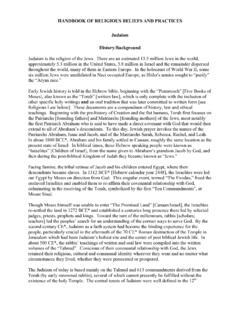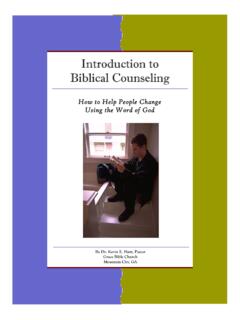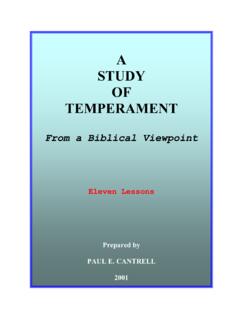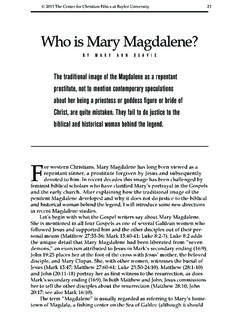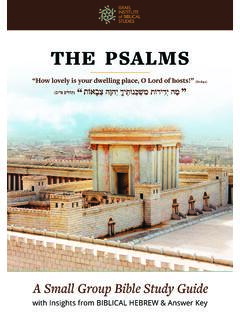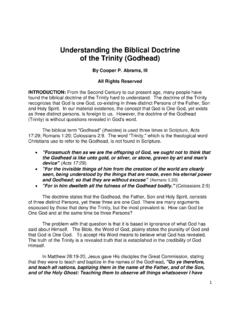Transcription of HANDBOOK OF RELIGIOUS BELIEFS AND PRACTICES …
1 HANDBOOK OF RELIGIOUS BELIEFS AND PRACTICES Judaism History/Background Judaism is the religion of the Jews. There are an estimated million Jews in the world, approximately million in the United States, million in Israel and the remainder dispersed throughout the world, many of them in Eastern Europe. In the holocaust of World War II, some six million Jews were annihilated in Nazi occupied Europe, as Hitler's armies sought to purify the Aryan race. Early Jewish history is told in the Hebrew bible, beginning with the Pentateuch [Five Books of Moses], also known as the Torah [written law], which is only complete with the inclusion of other specific holy writings and an oral tradition that was later committed to written form [see RELIGIOUS Law below].
2 These documents are a compendium of history, law and ethical teachings. Beginning with the pre-history of Creation and the fist humans, Torah first focuses on the Patriarchs [founding fathers] and Matriarchs [founding mothers] of the Jews, most notably the first Patriarch Abraham who is said to have made a direct covenant with God that would then extend to all of Abraham s descendents. To this day, Jewish prayer invokes the names of the Patriarchs Abraham, Isaac and Jacob, and of the Matriarchs Sarah, Rebecca, Rachel, and Leah.
3 In about 1800 BCE*, Abraham and his family settled in Canaan, roughly the same location as the present state of Israel. In biblical times, these Hebrew speaking people were known as Israelites [Children of Israel], from the name given to Abraham s grandson Jacob by God, and then during the post- biblical Kingdom of Judah they became known as Jews. Facing famine, the tribal retinue of Jacob and his children entered Egypt, where their descendents became slaves. In 1312 BCE* [Hebrew calendar year 2448], the Israelites were led out Egypt by Moses on direction from God.
4 This singular event, termed The Exodus, freed the enslaved Israelites and enabled them to re-affirm their covenantal relationship with God, culminating in the receiving of the Torah, symbolized by the first Ten Commandments , at Mount Sinai. Though Moses himself was unable to enter The Promised Land [Canaan/Israel], the Israelites re-settled the land in 1272 BCE* and established a centuries long presence there led by selected judges, priests, prophets and kings. Toward the turn of the millennium, rabbis [scholars; teachers] led the peoples search for an understanding of the correct ways to serve God.
5 By the second century CE*, Judaism as a faith system had become the binding experience for the people, particularly crucial in the aftermath of the 70 CE* Roman destruction of the Temple in Jerusalem which had been Judaism s holiest site and the center of post biblical Jewish life. In about 500 CE*, the rabbis teachings of written and oral law were compiled into the written volumes of the Talmud . Conscious of their covenantal relationship with God, the Jews retained their RELIGIOUS , cultural and communal identity wherever they went and no matter what circumstances they lived, whether they were persecuted or prospered.
6 The Judaism of today is based mainly on the Talmud and 613 commandments derived from the Torah (by early renowned rabbis), several of which cannot presently be fulfilled without the existence of the holy Temple. The central tenets of Judaism were well defined in the 12th HANDBOOK OF RELIGIOUS BELIEFS AND PRACTICES century CE* by Rabbi Moses Ben Maimon [the Rambam or Maimonides ] in his Thirteen Principles of Faith , which include a belief in one God and the eventual coming of a Messiah [ Anointed One ].
7 Judaism s tenets and PRACTICES have been further defined to varying degrees by branches ( denominations) of the faith. In 1948 CE*, shortly following World War II, the tiny State of Israel was born. It was intended to create a secure permanent homeland for the Jews. Israel s short history has been one of remarkable economic and artistic achievement, and of painful struggle for recognition, identity and survival. *As are also employed by most historians, the terms BCE [Before Common Era] and CE [Common Era] are generally used by Jews as they do NOT believe that a Messiah has yet been revealed and they, therefore, do not use the Christian terms BC [Before Christ] or AD [Year of Our Lord].
8 Theology/Major Teachings/ belief Judaism is the term for the religion of the Jewish people. It is the oldest of the three western monotheistic religions and so is the ancestor of both Islam and Christianity. At the heart of Judaism is the belief that there exists only one eternal God who is the creator and the ruler of the universe and all that is in it. God is transcendent and eternal, knowing and seeing everything. God has revealed His law [Torah] for the Jews, who are to serve as a light and example to the world.
9 Abraham, the biblical Patriarch was the first to give expression to this faith, and it is through him that the blessing and the inheritance from God to the Jewish people comes, particularly the promise of the land that has a central place in Jewish thought and practice. The essence of the Jewish faith is contained in the biblical Shema that is recited every morning and evening by a devote Jew: Hear O Israel the Lord is our God, the Lord is one. You shall love the Lord your God with all your heart, with all your soul, and with all your might.
10 And these words which I command you today shall be upon your heart. [Deuteronomy 6:4-6]. In addition to this and other scriptural mandates, Jewish practice incorporates an ever-growing body of rabbinic commentary and interpretation. RELIGIOUS Law: Traditionally, Jewish life is guided by the 613 Godly commandments derived from Torah. The Talmud (based on oral Torah), and the Code of Jewish law [ Shulchan Aruch ], arranged rabbinic ( scholarly) commentary on RELIGIOUS law, are highly specific about individual and community conduct.
